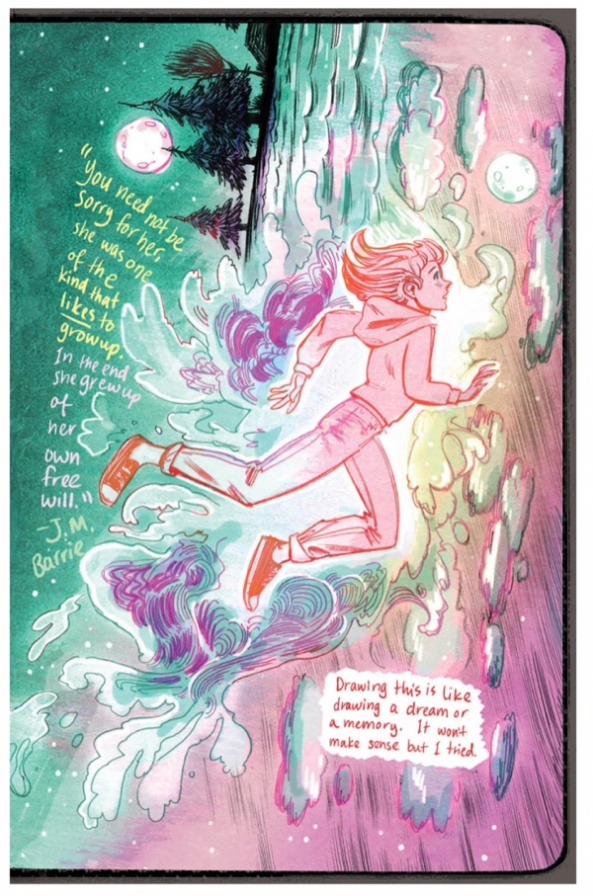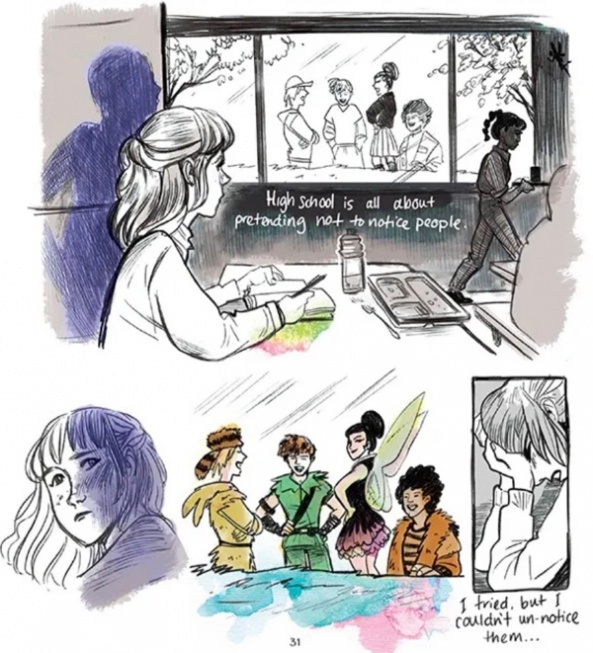All-ages graphic novels are hotter than ever. With so much great content out there and more arriving each week, sifting through it all can be a daunting task. Whether you’re a parent, caregiver, teacher, librarian or young reader, Multiversity’s #BookshelfBasics is here to help. By highlighting a blend of newly released and classic all-ages books, we’ll help you build your collection, even as your tastes and interests change. In today’s installment we look at “The Wendy Project,” which uses J.M. Barrie’s timeless classic, “Peter Pan,” to explore themes of loss, grief, the persistence of memory and the healing power of art.
Written by Melissa Jane OsborneCover by Veronica Fish
Illustrated, Colored and Lettered
by Veronica FishSixteen-year-old Wendy Davies crashes her car into a lake on a late summer night in New England with her two younger brothers in the backseat. When she wakes in the hospital, she is told that her youngest brother, Michael, is dead. Wendy ― a once rational teenager – shocks her family by insisting that Michael is alive and in the custody of a mysterious flying boy. Placed in a new school, Wendy negotiates fantasy and reality as students and adults around her resemble characters from Neverland. Given a sketchbook by her therapist, Wendy starts to draw. But is The Wendy Project merely her safe space, or a portal between worlds?
Okay, Let’s Start with the Basics
“The Wendy Project” is written by actor, writer, and new media creator Melissa Jane Osborne. Prior to delving into the comics medium, Osborne created and wrote “Campus Crush,” a scripted, choose-your-own-adventure style smartphone game for kids 13 and up. She also helped develop the “Episode” platform, which not only hosts “Campus Crush,” it allows registered users to create their own interactive stories. The book’s art is by Veronica Fish, who is probably best known for illustrating numerous early issues of Mark Waid’s “Archie” reboot and creating the concept art for the “Riverdale” TV series. Fish has also illustrated an array of other monthly series – including Boom! Studios’ “SLAM!” and Marvel Comics’ “Spider-Woman” – and done a ton of variant covers.

What’s It All About?
“The Wendy Project” is built around the narrative conceit that protagonist Wendy Davies has been given a sketch book – and an assignment – by her therapist. “Whatever you can’t say out loud, whatever seems too crazy for this world, DRAW IT,” the therapist says. “You owe me two pages next week.”
Wendy has yet to accept the reality of her little brother Michael’s death. He died in a dramatic car crash on the book’s second page, but Wendy insists that’s not true. She saw him fly away, up into the night sky.
Unlike Michael, Wendy and her other brother, John, both survived the car crash – physically, that is. Emotionally, they’re shattered. John copes by going mute, while Wendy goes deeper and deeper into the Neverland-inspired fantasy world she’s created.
In the hallway of her high school, one of her classmates becomes a pirate, while another becomes a mermaid. The town sheriff is Captain Hook, the cool kids are the Lost Boys, and the most popular girl is Tinker Bell.
Of course, none of these apparitions is real – or maybe they are . . . .
Notably, Wendy’s visions are always portrayed in a straightforward manner. There’s no magic fairy dust or dreamlike visual effect. She’s never alarmed or freaked out. She accepts what she sees as factual. To her, it’s all part of the real world.
Refreshingly, the story is not the more tale about grappling with what’s real and what isn’t. It’s about processing things that remain too raw and painful to face. It’s about Wendy’s heart wrenching journey from devastating tragedy to a place of acceptance. It’s about the heartbreaking decision to exchange life in a perpetual dream world for the pain of reality.

What Makes It Essential?
Both Melissa Jane Osborne and Veronica Fish borrow heavily from J.M. Barrie’s “Peter Pan.” Occasionally, Osborne interjects quotes from Barrie’s original text, as though Barrie himself were an omniscient narrator watching the story unfold.
Similarly, Fish doesn’t try change or reinvent the story’s visual tropes. Instead, she uses her considerable talents to recontextualize the classic imagery we already know. The result is a beautiful and highly emotional story within a story that grabs us by the hand and takes us on Wendy’s journey.
Continued below“The Wendy Project” is far from a simple retelling – nor does it ever pretend to be. Rather, Osborne and Fish reinscribe Barrie’s canonical text to make it more relevant, more immediate and more urgent. The story’s stakes have never been higher, which is why it all works so well.
Artistically, “The Wendy Project” is a tour de force. Physically, the book is the size and shape of an actual sketch book, complete with rounded corners. This is not a gimmick. Holding the book in your hands, flipping through its pages, it feels like you’re peering into someone’s personal notebook – the one place where they bare their soul and discover the truth within.
Fish draws scenes in the “real world” with a halftone pen and ink style. The line work is loose and spontaneous, but also realistic. The illustrations have depth. The environments are fairly detailed. Whenever Wendy slips into Neverland, however, Fish uses a bright, vibrant palette and colors outside of the lines. Some images merely have a splotchy dab of a single color, as though it’s a mere afterthought. Other scenes explode with color that radiates and slowly fades into the abstract. The real world is straightforward and anchored, while Neverland becomes a literal flight of fantasy. For Wendy, it’s a difficult choice. Right up to the very end, it’s not entirely clear which way she’s going to go.

How Can You Read It?
“The Wendy Project” came out four years ago, so it’s doubtful your going to find it on display at your local book store. You can definitely find a copy online, including numerous used copies at independent book shops and thrift stores around the country. You can also ask your local comics shop to order a copy. If digital is your thing, the ebook is available on all of the major platforms.

Why Should it be on Your Shelf?
“The Wendy Project” incorporates words and imagery from J.M. Barrie’s canonical text to create a wholly new story that soars past its source material.







